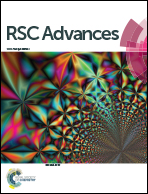Close-packed assemblies of discrete tiny silver nanoparticles on triangular gold nanoplates as a high performance SERS probe†
Abstract
Bimetallic nanocatalysts often display enhanced physical and chemical properties compared to those of their monometallic counterparts. Herein, we introduce a simple method to fabricate an island like array of tiny Ag nanoparticles bounded on triangular Au nanoplates as the surface-enhanced Raman scattering (SERS) substrate. The surface morphology of the synthesized nanoparticles was characterized via field emission scanning electron microscopy (FE-SEM), and atomic force microscopy (AFM). Rhodamine 6G (R6G) is used as a model analyte to evaluate the performance of the tiny Ag nanoparticle bounded triangular Au nanoplates as a SERS-active substrate and validate the SERS effect. The fabricated SERS substrate showed drastically enhanced intensity with a SERS enhancement factor as high as 107, which is enough to detect a single molecule, and excellent reproducibility (less than ±5%) of the signal intensity. This is because of the island-like tiny Ag nanoparticle bounded triangular Au nanoplates and their large number of “hot spots”. This substrate could also be used for label-free immunoassays, biosensing, and nanoscale optical antennas and light sources.


 Please wait while we load your content...
Please wait while we load your content...